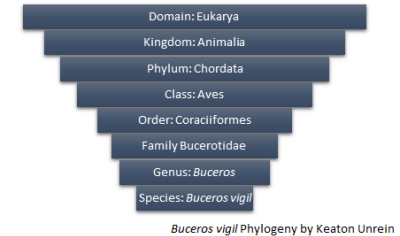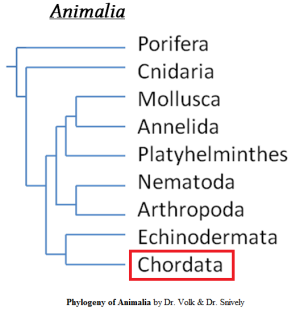Classification
This section goes into the taxonomic classifcation of the Helmeted Hornbill. It is important to first
understand what taxonomy is exactly. Taxonomy in a very basic way is
the description of diversity and naming of organism in a way that
shows the relationships between organisms. This system has many
different forms, with one of the more popular, and the one that this
site focuses
on, being the use of phylogenetics. This is basically the
classifying organisms through the using of their genealogical
relationships or better stated their ancestors (Wiley 1981). This
system shows relationships through the use of common ancestors. With
that let us jump right into the classification of the Buceros
vigil.
It is important to first
understand what taxonomy is exactly. Taxonomy in a very basic way is
the description of diversity and naming of organism in a way that
shows the relationships between organisms. This system has many
different forms, with one of the more popular, and the one that this
site focuses
on, being the use of phylogenetics. This is basically the
classifying organisms through the using of their genealogical
relationships or better stated their ancestors (Wiley 1981). This
system shows relationships through the use of common ancestors. With
that let us jump right into the classification of the Buceros
vigil.
Domain: Eukarya
The Buceros vigil is part of the domain Eukarya because of the fact that it has eukaryotic cells, a synapomorphy of eukaryotes. What characterizes a eukaryotic cell in the most basic sense is that eukaryotes contain nuclei and they contain membrane bounded organelles. On a more advanced, all eukaryotes evolved from the endosymbiosis of two bacteria cells (Margulis and Schwartz 1998). This theory was proposed by Lynn Margulis ijn 1966, but was not accepted. In her original paper she states, "the eukaryotic cell is the result of the evolution of ancient symbioses." It was not until the 1980s that her theory became accepted (Sagan 1967). A great example of a prokaryote is the bacteria Clostridium tetani, which causes the central nervous condition know as tetanus. An organism that joins the Buceros vigil with eukaryotic cells is the Macaroni Penguin (Eudyptes chrysolopus).
Kingdom: Animalia
The Kingdom Animalia is characterized by the fact that they are multicellular and heterotrophic, meaning that they must ingest other organisms for their energy. Chromosomally they are diploid, meaning they contain two full sets of their chromosomes (Margulis and Schwartz 1998). Another interesting organism of kingdom Animalia to check out is the Platypus (Ornithorhynchus anatinus).
 Phylum: Chordata
Phylum: ChordataChordates share the synapomorphy of a flexible backbone. While in many of these organisms this very flexible rod is maintained throughout its lifetime, in the Helmeted Hornbill, this flexible rod is only present during its embryonic life and is later replaced and with a more rigid backbone (Buchsbaum et al. 1987).
As you can see in the phylogenetic tree to the left the Chordata phylum is very closely related to the phylum Echinodermata. A great example of an Echinoderm can be found in the Stichopus chloronotus commonly know as the Greenfish. They are linked together by there deuterostome development. In a basic sense the early dividing cells of a zygote, a fused sperm and egg, become a mass of cells with an opening known as a blastula. Later the mass becomes know as a gastrula and what defines the deuterostomes is that the opening is what develops into the anus of the animal. This is in contrast with protostomes whose blastopore(the opening) eventually develops into the mouth (Margulis and Schwartz 1998). Another example of a chordate would be the Red-eyed Tree Frog (Aglachnis callidryas)
Class: Aves
The class Aves contains the many birds of the world. This class contains the most species of all the terrestrial vertebrates. Organisms of this class are characterized by their many different characteristics that adapt them for aerial flight. Birds are extremely close ancestral relatives to reptiles. Some even feel that they are so related that they should be placed under the same class. Yet, birds are distinguished from their reptilian relatives by the feathers that cover their exterior (del Hoyo et al. 2001). Another example of an organism of the Aves class that you may be more familiar with is the Northern Cardinal (Cardinalis cardinalis) or the Domestic Chicken (Gallus gallus). Someone who studied and published information on all types of bird is Josep del Hoyo. He is one of the main authors of The Handbook of the Birds of the World. Check out his story and studies right here.
Order: Coraciiformes
Organisms of the order Coraciiformes have many characteristics that are not necessarily obvious. Yet, further invetigation of these birds has lead to the many all embodying characteristics of this order. To start the foot structure of these birds is homologous across this order. Their toes are know as being syndactylous meaning that they have two or three joined toes that point forward. This order also share the structure in certain bones in the roof of its mouth, the lack of muscles in the leg, and finally the similarity in their feather patterns (del Hoyo et al. 2001).
Family: Bucerotidae

The most obvious characteristic that is seen in all Bucerotiformes is their large curved bill and projecting casque, both of which can be better seen in the image to the right. An organism that has been compare to the hornbills because of its bill similarity is the Toucan and example being the Toco toucan(Ramphastos toco). Yet these two families of birds that appear similar are actually very different. Further investigation shows a anatomical synapomorphy in the lack of the third central lobe in their kidneys, and long flattened eyelashes within this family. They are also all omnivores with varying amounts of carnivorous and frugivorous variation (Kemp 1995). One of the leading advocates for this family of animals is Pilai Poonswad. She has researched the hornbills extensively and I recommend you check out her website.
Genus: Buceros
The Buceros genus of hornbills are a large group of hornbills containing 4 different species of Hornbill as you can see in the phylogeny above. These species are joined by the fact that they have a uropyial gland, used to color the feathers of the bird (Kemp 1995).
Species: Buceros vigil
Buceros vigil can be translated to "lively hornbill" from its Latin roots. The autapomorphy of the species lies in the structure of its casque (Kemp 1995).
Continue on to learn about the
Buceros vigil's Habitat and Geography
or
Head back to the homepage

